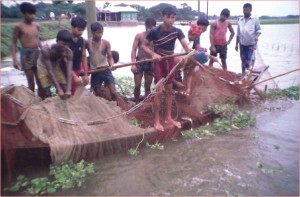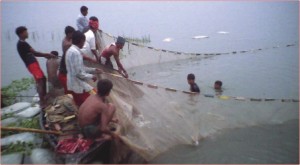| Journey through Bangladesh
From Comilla
Fishing at Ghughura Lake
Zakir Azad
 THE fishermen of Comilla are smiling again. Once again, they are allowing themselves to dream. Lake Ghughura, the source of hopes and dreams for generations, is alive once more. Situated between Comilla's Chandina-Daudkandi and Chadpur's Kachua, Lake Ghughura encompasses an area of 120 square miles. The lake is famed as the largest spawning grounds of fish in the nation. From time immemorial the lake has been providing hundreds of thousands of people with their daily protein requirements. Yet, for the fishermen of the lake, the last few years have been shrouded in disappointment and frustration. THE fishermen of Comilla are smiling again. Once again, they are allowing themselves to dream. Lake Ghughura, the source of hopes and dreams for generations, is alive once more. Situated between Comilla's Chandina-Daudkandi and Chadpur's Kachua, Lake Ghughura encompasses an area of 120 square miles. The lake is famed as the largest spawning grounds of fish in the nation. From time immemorial the lake has been providing hundreds of thousands of people with their daily protein requirements. Yet, for the fishermen of the lake, the last few years have been shrouded in disappointment and frustration.
Lake Ghughura is fifteen miles in length and 8 miles in breadth. It covers a total area of 120 square miles. Just a decade ago nobody would go to the lake alone even in broad daylight. Some feared malicious spirits, others plain robbers. The lake has spawned lots of fantastic tales, but why the lake is called Ghughura, no one seems to know for certain. But many, including Abdul Malek of Chandina, Baraykrishnapur, and Nakul Chandra Sharkar of Ghughuragram, Chadpurkachua, says that people would lose their way when they traverse the lake, either by boat during the rainy seasons, or by foot during the dry seasons. They would return home exhausted, after a day spent trying to find a way back. This led to people calling it Lake Ghughura. The lake once boasted a surfeit of local fish. Locals say shol, boal, gojar air, magur, shing, koi, pabda, tengra, chapila, bujuri, taki, baghair, rui, katla, sorputi, kanchanputi, jatputi, chingri bata, bhangna, kajli, puti, meni, boin, darkina were just some of the varieties to be found at the lake. These fish would be spawned and harvested entirely naturally. Most water bodies would have fish even after the rainy season. When the rainy season started, the schools of fish would make their way into the sanctuary of the open waters of the lake. According to the residents of Chandina, Daudkandi and Kachua, just two decades ago the stench of fish made it difficult to walk near the banks of Ghughura. This had not been the case for a while. But recently, after a long wait, the lake is again beginning to return to its old ways. The glut of fish is beginning to attract all varieties of ducks, storks and other birds to the lake.
If current trends are anything to go by, sweet water fish in Bangladesh are fast approaching extinction. Factors such as the use of deadly insecticide on water bodies and problems such as industrial waste, over-fishing, increased consumption of fish, use of illegal fishing nets and increase in population has all led to increased water pollution, wide-spread diseases in the fish population, and commercial fishing of hatchlings and this in turn has lead to a dwindling population of local small fish throughout the nation.
 The seemingly unlimited supply of fish from Lake Ghughura has again begun to satisfy demand for the markets of Dhaka, Comilla and Narayanganj. Goni Aziz expects to catch fish worth at least taka 1 lakh from them. Yet his capital investment was just 20,000 taka. During a visit to Boroy Krishnapur village of Chandina last week, I came across Jahangir who had caught 100 large kois which he sold for taka 3000. These 3 year old kois would have sold for more in Dhaka, he says. Rakib Bhuiyan of Boroy Krishanpur village says that the owners do not themselves know how much koi they have in their enclosures and how old these koi-s are. The fish stay within the enclosures during the dry season, and they scatter around the lake during the rainy seasons. The kois return to their enclosures before the end of the rainy season. These days it doesn't work like that anymore. When the fish are venturing out into the open waters during the rainy seasons, they are being gobbled up by unscrupulous fishermen using 'current' or other types of nets. As such, owners are forced to harvest their enclosures each year. This is part of the reason why aged kois and varieties of similar local fish are hard to come by these days. The seemingly unlimited supply of fish from Lake Ghughura has again begun to satisfy demand for the markets of Dhaka, Comilla and Narayanganj. Goni Aziz expects to catch fish worth at least taka 1 lakh from them. Yet his capital investment was just 20,000 taka. During a visit to Boroy Krishnapur village of Chandina last week, I came across Jahangir who had caught 100 large kois which he sold for taka 3000. These 3 year old kois would have sold for more in Dhaka, he says. Rakib Bhuiyan of Boroy Krishanpur village says that the owners do not themselves know how much koi they have in their enclosures and how old these koi-s are. The fish stay within the enclosures during the dry season, and they scatter around the lake during the rainy seasons. The kois return to their enclosures before the end of the rainy season. These days it doesn't work like that anymore. When the fish are venturing out into the open waters during the rainy seasons, they are being gobbled up by unscrupulous fishermen using 'current' or other types of nets. As such, owners are forced to harvest their enclosures each year. This is part of the reason why aged kois and varieties of similar local fish are hard to come by these days.
Over 93 social development-oriented fishing projects have started initiatives to help expand the population of these varieties of fish by digging special pits to act as safe spawning grounds for these fish. Safe havens are being created for these fish through the culture of fungi within these projects, which is an ideal food source for these fish. According to the Ministry of Fisheries, there are 56 such safe haven projects around the nation. A fisheries administrator in Comilla said it was essential that the spawning grounds have such safe havens. Otherwise local varieties of fish will slowly become extinct. This requires public awareness of the situation. The projects have already started producing local varieties of small fish, albeit in small quantities. Many of these projects have dug up separate pits to create safe havens for the production of koi, shol, taaki, shing, mola, tengra, khalisha and menimach. Founder of Purodha Daudkandi's Dhanuakhola Matsha Khamar and Pankouri Fisheries, Sunil Kumar Roy, and founder of Bismillah Matsha Khamar informs that their projects produce between 25 to 30 tonnes of koi every year. They have tried identifying varieties of local small fish that can be produced along with Rui, Katla, Silver, Mrigel, Tilapiya and Pangash varieties. This will require a lot of help and technical assistance.
Fisheries are naturally considered an ideal field of enterprise in the nation. This nation boasts of 750 rivers of all scales, and a virtually infinite number of lakes, ponds and various water bodies. These water bodies account for 63 percent of the animal-protein intake of the nation.
Copyright
(R) thedailystar.net 2008 |
|

